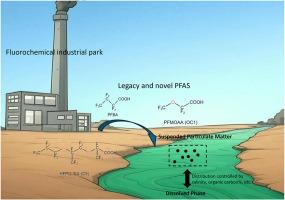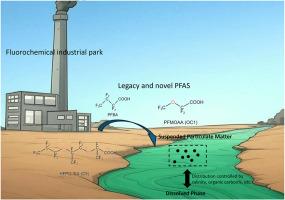短链遗留和新型全氟物质(PFAS)在河流-河口-海岸连续体中溶解相和颗粒相之间的分配行为
IF 7.3
2区 环境科学与生态学
Q1 ENVIRONMENTAL SCIENCES
引用次数: 0
摘要
研究了小清河从源头到河口的溶解相和颗粒相样品中残留的全氟烷基物质(PFAS)和新的全氟烷基物质(PFAS)。小清河下游地区受某氟化工园区排放废水影响严重,总PFAS浓度极高(溶解相7月高达12.3万ng/L, 12月高达217万ng/L,悬浮颗粒物[SPM] 7月高达3.36万ng/g dw, 12月高达741,000 ng/g dw)。在样品中观察到各种PFAS物质:除了高浓度的全氟辛酸(PFOA)外,还发现了几种浓度显著的全氟聚醚羧酸(PFECAs),占溶解相的约17%-35%。在颗粒相中,六氟环氧丙烷三聚酸(HFPO-TrA)被证明是浓缩的,它与全氟辛酸一起占全氟辛酸总浓度的95%以上。研究了PFAS在溶解相和颗粒相之间的分布行为,发现全氟丁酸(PFBA)和全氟甲氧乙酸(PFMOAA)等短链PFAS物种参与了溶解相和颗粒相之间的分布。这种分配行为是季节性的,并依赖于各种环境参数,如盐度、TOC和营养物质。我们认为这可能是由于颗粒表面的静电相互作用超过了某些短链PFAS的经典疏水相互作用,并且可能与海洋中某些软体动物PFAS的生物浓缩过程有关。本文章由计算机程序翻译,如有差异,请以英文原文为准。


Partitioning behavior of short-chain legacy and novel perfluorinated substances (PFAS) between dissolved and particulate phases in a river-estuary-coast continuum
In this study, legacy and novel perfluoroalkyl substances (PFAS) in dissolved and particulate phase samples of Xiaoqing River from the headwater to estuary region were investigated. The downstream area of Xiaoqing River was found to be heavily influenced by discharged wastewater from a fluorochemical industry park and possessed an extremely high total PFAS concentration (as high as 123,000 ng/L for July and 2,170,000 ng/L for December in dissolved phase, and 33,600 ng/g dw for July and 741,000 ng/g dw for December in suspended particulate matter [SPM]). Various PFAS substance were observed in the samples: apart from a high concentration of perfluorooctanoic acid (PFOA), several perfluoropolyether carboxylic acids (PFECAs) were also found in remarkable concentration, constituting ∼17 %–35 % of the dissolved phase. In the particulate phase, hexafluoropropylene oxide trimer acid (HFPO-TrA) was shown to concentrate, and together with PFOA it made up over 95 % of the total PFAS concentration. The distribution behavior of PFAS between dissolved and particulate phases was studied, and we observed that short-chain PFAS species such as perfluorobutanoic acid (PFBA) and perfluoromethoxyacetic acid (PFMOAA) involved in the distribution between dissolved and particulate phase. Such partitioning behavior was found to be seasonal and dependent on various environmental parameters, such as salinity, TOC and nutrients. We propose that this may be due to electrostatic interaction on the particle surface surpassing the classical hydrophobic interaction for certain short-chain PFAS, and it may be associated with the bioconcentration process of PFAS in certain mollusk species in the ocean.
求助全文
通过发布文献求助,成功后即可免费获取论文全文。
去求助
来源期刊

Environmental Pollution
环境科学-环境科学
CiteScore
16.00
自引率
6.70%
发文量
2082
审稿时长
2.9 months
期刊介绍:
Environmental Pollution is an international peer-reviewed journal that publishes high-quality research papers and review articles covering all aspects of environmental pollution and its impacts on ecosystems and human health.
Subject areas include, but are not limited to:
• Sources and occurrences of pollutants that are clearly defined and measured in environmental compartments, food and food-related items, and human bodies;
• Interlinks between contaminant exposure and biological, ecological, and human health effects, including those of climate change;
• Contaminants of emerging concerns (including but not limited to antibiotic resistant microorganisms or genes, microplastics/nanoplastics, electronic wastes, light, and noise) and/or their biological, ecological, or human health effects;
• Laboratory and field studies on the remediation/mitigation of environmental pollution via new techniques and with clear links to biological, ecological, or human health effects;
• Modeling of pollution processes, patterns, or trends that is of clear environmental and/or human health interest;
• New techniques that measure and examine environmental occurrences, transport, behavior, and effects of pollutants within the environment or the laboratory, provided that they can be clearly used to address problems within regional or global environmental compartments.
 求助内容:
求助内容: 应助结果提醒方式:
应助结果提醒方式:


